U-Pb zircon geochronology
Introduction
This page provides a short tutorial leading through some steps that are required for obtaining U-Pb zircon ages using the UCLA ims1270 ion microprobe:
- Oxygen flooding
- Energy scan and offset
- Centering the ion image in the field aperture
- Mass calibration
- Presputtering and data acquisition
- Interelement calibration and precision
Oxygen flooding
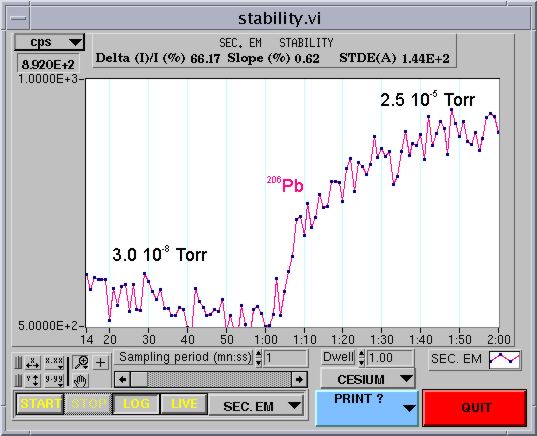
"stablitiy.vi" shows a ~50% increase in 206Pb counts.
Pb isotope intensity of zircon during O- ion bombardement is significantly enhanced if the sample surface is saturated with regard to oxygen. During zircon analysis, oxygen gas is leaked through a valve into the ims1270 sample chamber. Stability.vi (right) shows the ~50% increase in 206Pb counts measured on AS3 zircon that was observed while gradually opening the leak valve up to a final pressure of 2.5 10-5 Torr. Note: in order to open EP10, EP11 or to vent the door, the leak valve has to be closed (1.5 turns clockwise).
Energy Scan and Offset
At the beginning of an analytical session or when analytical parameters such as primary beam intensity or spot size were changed, energy offsets for all measured ion species must be determined. Pb+, U+, and UO+ have characteristic energy distributions (see Figure) and therefore optimizing intensities and finding a region in the energy distribution sufficiently stable to minimize interelement fractionation is a prerequisite for analysis. The difference between the nominal extraction potential (= 10 kV, equivalent to 0 V offset) and the maximum of the observed energy distribution measured on a standard zircon determines the offset voltages to be applied during analysis. For the example to the right, offset values for 204Pb+ (and other Pb-species) are: +13V, for U+ (and Th+) -10V, and for UO+ +10. These values are to be entered in the condition file (offset in "analysis_species_table.vi").

Characteristic energy distributions for Pb+, U+, and UO+.
Centering the ion image in the field aperature
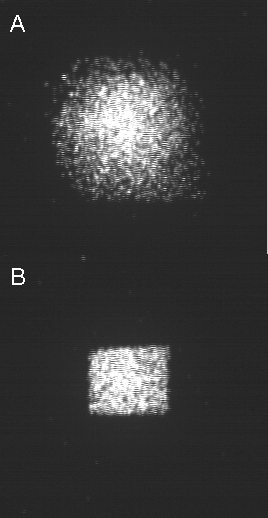
Centering the secondary ion image in the center of the field aperture (FA) is necessary for each new analysis spot because primary beam paths and conditions of secondary ion extraction vary over the area of the sample surface,in particular when spot-to-spot movements over large distances (few mm) are required. The sequence is as follows:
- Quit "Acquire"
- Go to "Tuning"
- Press: "Ions on" + "Circle Mode" + "Image" (Cameca Keyboard)
- Press: "LT1" + "Def A" + "Fast"(Cameca Keyboard)
- Use X and Y thumbwheel to center ion image in FA. If ion image is weak or not visible, slightly adjust "Mass" thumbwheel or increase gain using "Channel Plate" thumbwheel. Figure to the right shows the HfO+ image on AS3 zircon (~25 micron spot) for FA width sufficiently large to transmit the entire secondary ion beam (A), wheras B shows the effect of a smaller FA that blocks incoming secondary ions from the periphery of the crater. This minimizes surficial Pb contamination from more slowly sputtered edges. Note: "LT1 Def A" values for X and Y should be <1000. If not, repositioning of the primary beam is required
- When centering is complete , press "Rectangle Mode" + "EM" (Monocollection) on Cameca Keyboard
- Quit "Tuning"
- Go to "Analysis Definition". This opens "analysis_definition.vi"
- Under "Condition" select "Edit Condition" (you may change cycle number, pre-sputter time in "analysis_condition.vi", or offsets in "analysis_species_table.vi")
- Under "Calibrate" select "Calibrate from Condition"
- In "calibration.vi" window, select "Calibration Aid Manual" and "Start". This will start the mass calibration procedure.
Mass calibration
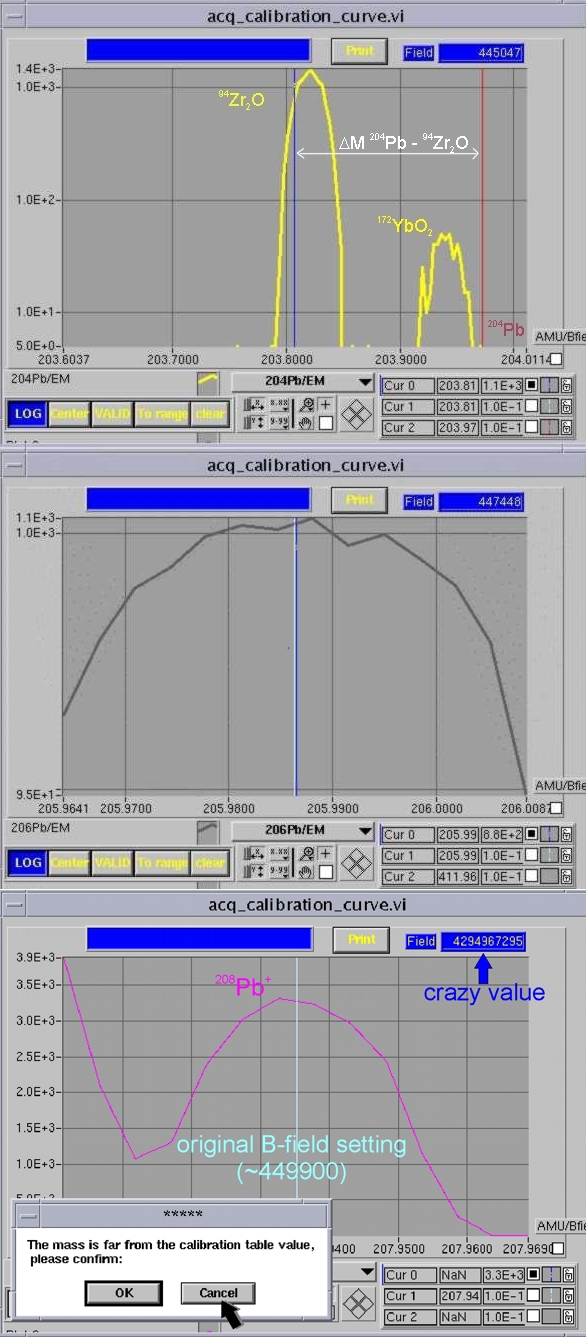
Prior to each analysis, the magnet is cycled over the entire mass range to be analyzed and centered for each mass (acq_calibration_curve.vi). The mass range for each peak is set by two parameters:
- Mass resolution (in "analysis_definition.vi" select "Anal. Par." and "Edit": type 5000 as mass resolution and confirm with "Set"). Note: if CIPS had to be restarted, the mass resolution is set to default = 300.
- #dM. Default is 4.0. Once all peaks are centered, #dM can be changed to 1.3 (except for 204Pb which should remain at 4.0 or - if peak is close to the margins of the mass window - be increased to 6.0).
Examples are shown for 204Pb, 206Pb, and 208Pb. Note that the 204Pb signal is typically too small to perform magnet centering on 204Pb directly. Instead, a nearby reference mass (94Zr2O) is used to center the magnet (blue cursor) whereas the B-filed during analysis is set for 204Pb (red cursor).
Further steps in mass calibration
- If peak is well defined, press "Center" + "Valid"
- If intensities of 207Pb, 208Pb, or even 206Pb are low (<100 cps), be aware that there is a risk of miscentering the peak. This could also accidentally happen for the case a nearby intereference is higher in intensity (see Fig. for 208Pb).
-
If miscentering accidentally has occurred (note "crazy" B-field
value in 208Pb scan), a window "mass is far from the
calibration..." pops up after pressing "valid". Select "cancel",
go back to a previous mass, then again to the miscentered
mass. This time, find peak manually by dragging cursor. If
insecure about peak position, the following is recommended:
- Check mass centering on AS3 only; or
- Manually drag the cursor relative to how the B-field values
changed on 94Zr2O+
- After cycling through all mass stations, press "Apply" on calibration.vi window. If masses were off by >10 bits, redo centering: "Quit" calibration.vi and "Calibrate from condition" again.
- "Apply" on "Analysis Definition"
- "Acquire" window pops up: you are ready to press "Start". Change sample name!
Presputtering and data acquisition
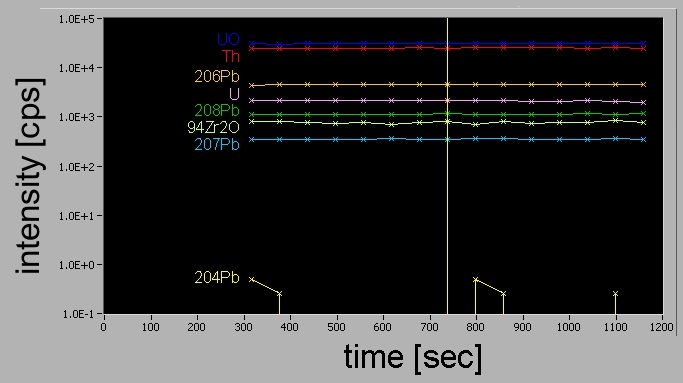
Presputtering ion image
In order to stabilize the secondary ion signal and to remove surface contamination, the primary beam is focused on the sample surface for a certain time period prior to data acquisition. In this example (right), the duration of the presputtering was 3 min. Subsequently, intensities were measured in 15 magnet cycles. Isotopic ratios are then calculated using raw intensities corrected for electron multiplier dead-time and drift-corrected mid-analysis values.
Interelement calibration and precision
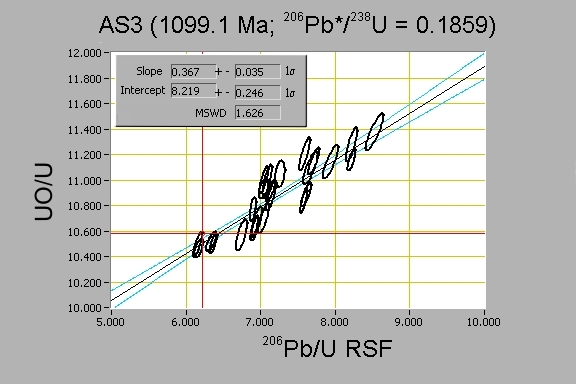
Calibration of U and Pb
Comparison of SHRIMP II and ims1270
Interelement fractionation between U, Th and Pb during ion microprobe analysis is monitored using well-characterized standards of known isotopic composition (e.g., AS3, 91500). Resulting age uncertainties critically depend on how well this fractionation can be monitored. Typically, raw U-Pb ratios are corrected for common-Pb (e.g., by using the 204Pb signal). Interelement fractionation between U and Pb commonly varies between ~5 and ~10 (calculated as (Pb/U)measured/(Pb/U)true). These values are plotted as 206Pb+/U+ RSF (relative sensitivity factor) against UO+/U+ and regressed as a linear function (slopes of ~0.5±0.2 are typically determined). This allows for calibrating the U-Pb relative sensitivity as a function of UO+/U+ measured on the unknowns.
To better characterize instrumental fractionation and to evaluate the potential for improved standardization techniques, we analyzed 54 of a total of 62 fragments of zircon megacryst z6266 (TIMS weighted mean age of 559.0±0.2 Ma) mounted on a single epoxy disk. The same mount was also analyzed by Geological Survey of Canada (GSC) researchers using the GSC SHRIMP II ion microprobe (Stern and Amelin, 2003). In our comparison, we determined that variations in U and Pb instrumental fractionation, sputter yield, detection efficiency (useful yield) and analytical reproducibility are very similar for both, the UCLA and GSC instruments, despite prominent differences in design and analytical conditions. In contrast to the SHRIMP II results of Stern and Amelin (2003), we find no discernible geometry effect resulting from secondary ion steering in the UCLA data ("LT1 Def A"). This suggests that variations in interelement fractionation during ion bombardment are largely independent of instrumental design and that interelement fractionation in ion microprobe U-Pb analysis can be monitored to an external reproducibility of ~1-2%. Reproducibility on z6266 is slightly lower than the ~3% standard deviation that we and others (Schmitz et al., 2003) typically observe for replicate analyses of our currently used standard AS3, for reasons that remain as yet unresolved. Future development of alternative standardization techniques will therefore remain an essential part of our efforts to improve U-Pb zircon dating by ion microprobe and other microanalytical techniques.
Literature:
Schmitz MD, Bowring SA, and Ireland T (2003)Evaluation of Duluth Complex anorthositic series (AS3) zircon as a U-Pb geochronological standard: New high-precision isotope dilution thermal ionization mass spectrometry results. GCA 67, 3665-3672
Stern RA, and Amelin, Y. (2003) Assessment of errors in SIMS zircon U-Pb geochronology using a natural zircon standard and NIST SRM 610 glass. Chem Geol 197, 111 142